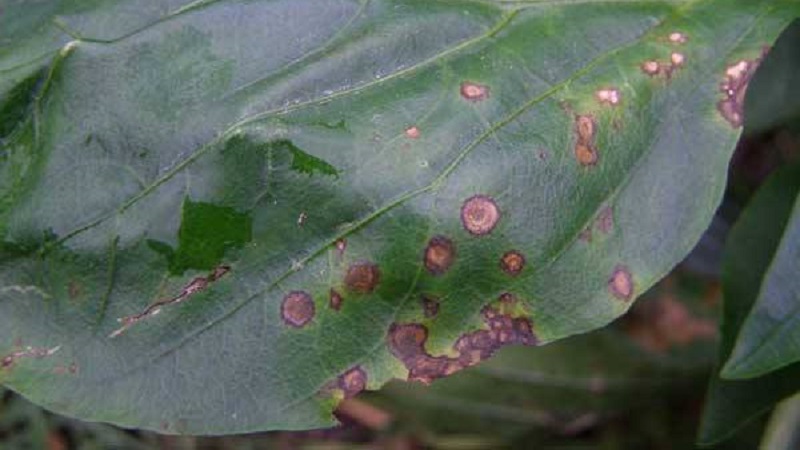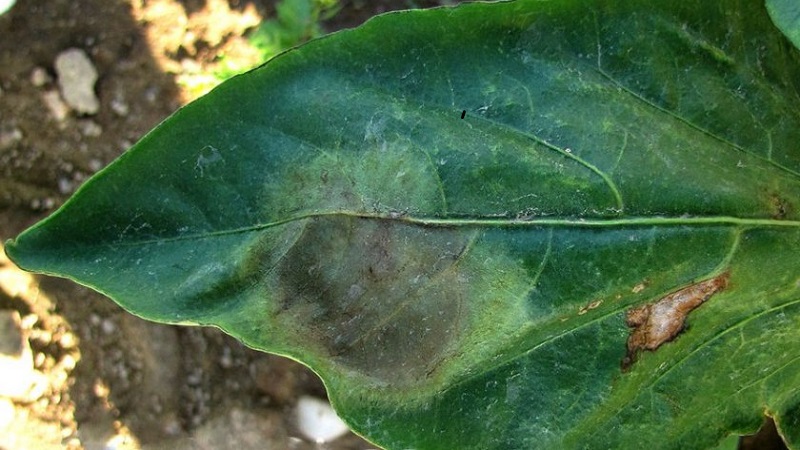What to do when brown spots appear on pepper
Pepper is a favorite crop of many vegetable growers, rich in vitamins and antioxidants. With the sun, water and regular care, the vegetable will delight you with a rich harvest. But there are no plants that are resistant to all diseases and pests. When growing peppers, gardeners often face various problems. One of them is the appearance of spots on leaves and fruits.
From the article you will find out why brown spots appear on the leaves on the pepper, how to cope with this and how to treat the plant for prevention.
The content of the article
Causes of pepper stains
The main reason for the appearance of spots on the fruits and leaves of bell pepper is improper care... The spots appear primarily on the lower leaves. As the disease progresses, they grow and capture the fruits. Cracks appear on the peppers, through which pathogens enter. To avoid this, you need to know the main causes of black spots on the pepper.
In the photo - a pepper affected by the disease.

Diseases and pests
Sweet peppers - a capricious garden crop... It is often affected by bacterial or infectious diseases and is susceptible to pest attacks.
Protecting plants once and for all will not work, since insects and microorganisms quickly adapt to new conditions. The most effective control method is to get rid of conditions favorable for pest reproduction.
The main diseases affecting pepper and forming brown and white spots on it:
- late blight (pictured below);
- alternaria;
- cladosporiosis;
- black bacterial spot;
- top rot.
The reasons for the spread of these diseases are fungi and bacteria.... It is difficult to cure them. Most often, chemicals are used. But they may not save the affected plants either.
Possible consequences:
- wilting of seedlings;
- loss of leaves or color change from green to yellow;
- the appearance of spots on the leaves, and then on the fruits;
- the death of individual plants or all plantings.
Causes of diseases:
- soil contamination;
- using diseased or untreated seeds;
- too frequent plantings;
- poor ventilation;
- too low or high air temperature, temperature drops;
- non-compliance with irrigation regimes - lack of moisture or excess.
Disease-causing fungal spores are spread across the site with the help of wind, water and insects.
The best ways to fight disease are planting surveillance and prevention.

If signs of illness are detected recommended:
- remove damaged parts or the suspicious plant itself;
- revise the conditions for caring for plantings;
- treat the beds with appropriate chemical or folk remedies.
Preventive measures to control disease:
- purchase seeds only from trusted manufacturers;
- choose disease-resistant varieties and hybrids;
- carry out pre-planting seed preparation: hardening, sterilization, treatment with growth and immunity stimulants;
- observe agrotechnical rules for vegetables: crop rotation, water and temperature regimes;
- fertilize the soil;
- fight pests and treat plantings from diseases.
Another one problem causing pepper mottling, Are pests: aphid, spider mite (pictured), naked slugs, whitefly.

Improper care and environment
Improper care or lack of necessary conditions is:
- non-compliance with crop rotation;
- lack of nutrients;
- excessive or insufficient watering;
- poor ventilation and dense plantings.
The problem of any greenhouses and small vegetable gardens is crowded plantings, lack of space for the correct placement of plants and for maintaining crop rotation.
In such cases the soil is depleted and filled with toxinsthat negatively affect seedlings. They become sources of diseases and pests. For this reason, planting peppers in the same place is highly discouraged. Pepper should not be adjacent to tomatoes, eggplants and potatoes. The plots are divided into several zones, which change with each other every season.
Read also:
One more problem, due to which spots appear on sweet peppers in the greenhouse - a lack of nutrients in the soil, in particular nitrogen. Lack of nutrition becomes noticeable after planting seedlings, during the active growth of the bushes. Lack of nitrogen in the soil can lead not only to stains on greenery and fruits, but also to lower yields and stunted plant growth.
Optimal water irrigation - one of the conditions for the successful growth of pepper and a good harvest. But sometimes the conditions are not met, and this leads to disastrous consequences. Some diseases develop precisely due to excessive watering or, conversely, due to a lack of moisture.
Important! Determining the required amount of moisture is not difficult. The soil in the beds should be soaked to a depth of 60-70 cm, no more. Watering is carried out as needed when the soil in the garden dries up.
Plants in greenhouses often suffer from plant density and lack of air... The result is mottling and sugar-like bloom on the underside of the leaves. If a ventilation system is not provided, then the room must be ventilated in the heat. And even if you have a lack of space in the greenhouse, it is better to respect the recommended distance between plants.

How to get rid of stains
Sweet pepper diseases can be recognized by the appearance of the affected plant and by the type of spots.... Knowing how to treat spots on bell peppers and what are the initial signs of disease, you can choose the right control measures to save the crop.
Drugs
Modern chemicals are designed both for the prevention and for the treatment of plant diseases. Unfortunately, they cannot be used uncontrollably, they can harm vegetables by filling them with nitrates, or burn them.
Universal remedies for all diseases and pests are biological products of the latest generation... They fight pests, diseases, destroy harmful fungi and bacteria, do not accumulate in vegetables, and increase plant immunity.
Their disadvantages are that not all of them are universal, and disease-causing bacteria quickly get used to them. The drugs often have to be changed.
Chemicals that deal with spotting, - these are copper-containing compounds, such as "HOM", "Oxyhom", copper oxychloride and others. When using them, remember that they harm not only plants, but also beneficial insects - bees, wasps. And even a person. Use personal protective measures when spraying your garden.
Insects - carriers of diseases - the Colorado potato beetle, locusts, cicadas can be dealt with with pesticides. But this should be done during the period of spread of bacteria carriers.
Important! The use of chemicals is unacceptable during the flowering period and undesirable during fruiting.

There are also proven ways to get rid of specific diseases:
- apical rot is treated with milk of lime or calcium chloride;
- sclerotinosis - with a mixture of fungicide and lime;
- late blight is destroyed by special drugs: "Ridomil-Gold", "Gamair", "Bravo", "Quadris", "Glyokladin", "Trichodermin";
- Alternaria can be defeated only with the help of complex fungicides;
- from insects help drugs "Karbofos", "Iskra", "Decis" and others.
The effectiveness of the use of chemical and biological products is associated with regularity and correctness of application. Read the recommendations and dosages on the package carefully. Some formulations are suitable for prophylactic treatment, others are only for direct disease control.
Reference. Processing is carried out on average once a month. For some infections, more often.
Folk remedies
Folk remedies less effective at fighting hordes of pests or bacterial infectionsthat have already amazed your landings. But these are excellent prophylactic agents that are safe for plants and humans.
Traditional methods of dealing with garden pests:
- Do not flood the plants, as high humidity is the habitat of pests.
- Remove and remove weeds regularly from the garden.
- Sprinkle the soil with a mixture of ground tobacco and lime.
- Mustard, ground pepper, coffee smell scare away harmful insects.
- Between the rows, if possible, plant calendula, lavender, nasturtium, delphinium, marigolds, tansy, parsley - slugs do not like their characteristic smell.
- Dandelion juice, crushed onions and garlic will help scare off spider mites.

To fight disease:
- before planting, nitrogen-containing fertilizers are introduced into the soil - manure, chicken droppings;
- make calcium in the form of limestone or ground chicken shell;
- use soapy water, ash, tobacco dust, onion husks.
Agricultural rulesto help you grow a healthy crop:
- Choose resistant seeds and harden them.
- Carry out pre-sowing treatment.
- Timely destroy the affected bushes, remove them with a root and a clod of earth, burn them away from the beds.
- Don't use diseased plants to create humus.
- Be sure to disinfect the greenhouse and vegetable garden soil after harvest and in early spring before planting.
- Weed, prevent weeds from growing, and loosen the soil around the plants.
- Be sure to conduct daily monitoring of the plantings, pay attention to drooping plants, yellowed and fallen leaves, seedlings that have stopped growing. Watch for changes in the color of the stem, the presence of insects and their larvae.
Using folk methods to combat pepper spotting is the best way to avoid massive infections and save the crop.
Conclusion
Spotting is a common name for pepper diseases that can lead to the loss of part of the crop and even all the plantings on the site. Spots arise for several reasons, which together lead to sad consequences. In order not to lose the fruits of your labor, before planting, carefully study the basic rules for caring for plants and follow the recommendations of experienced vegetable growers.